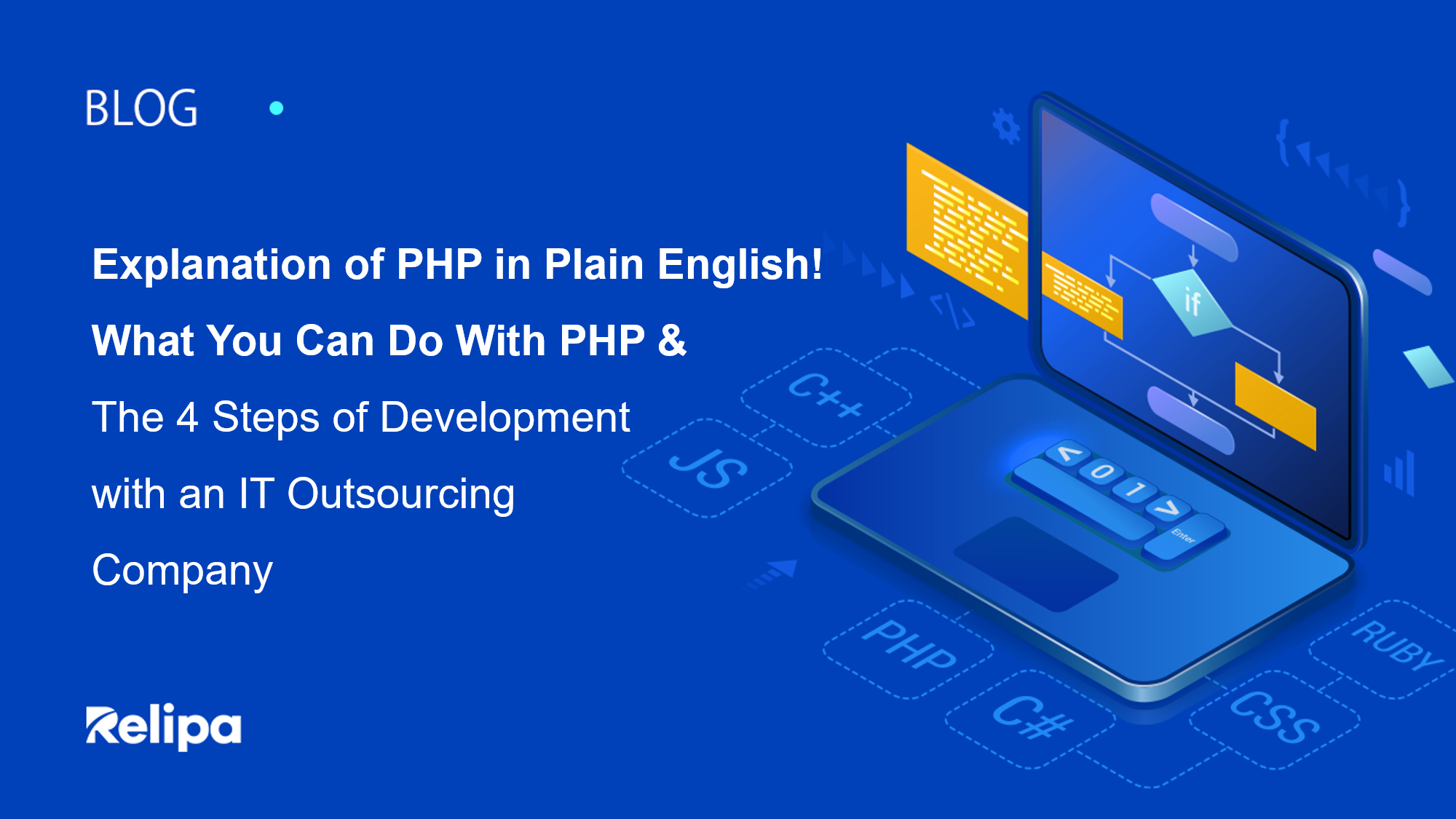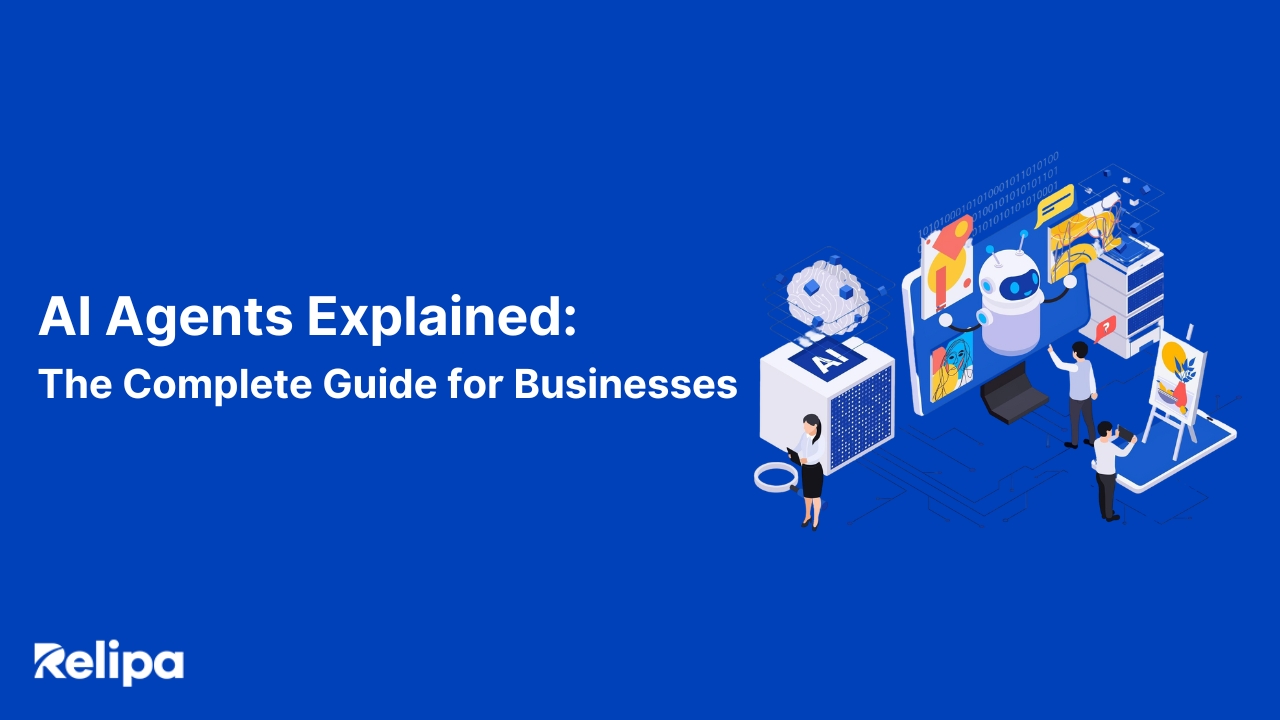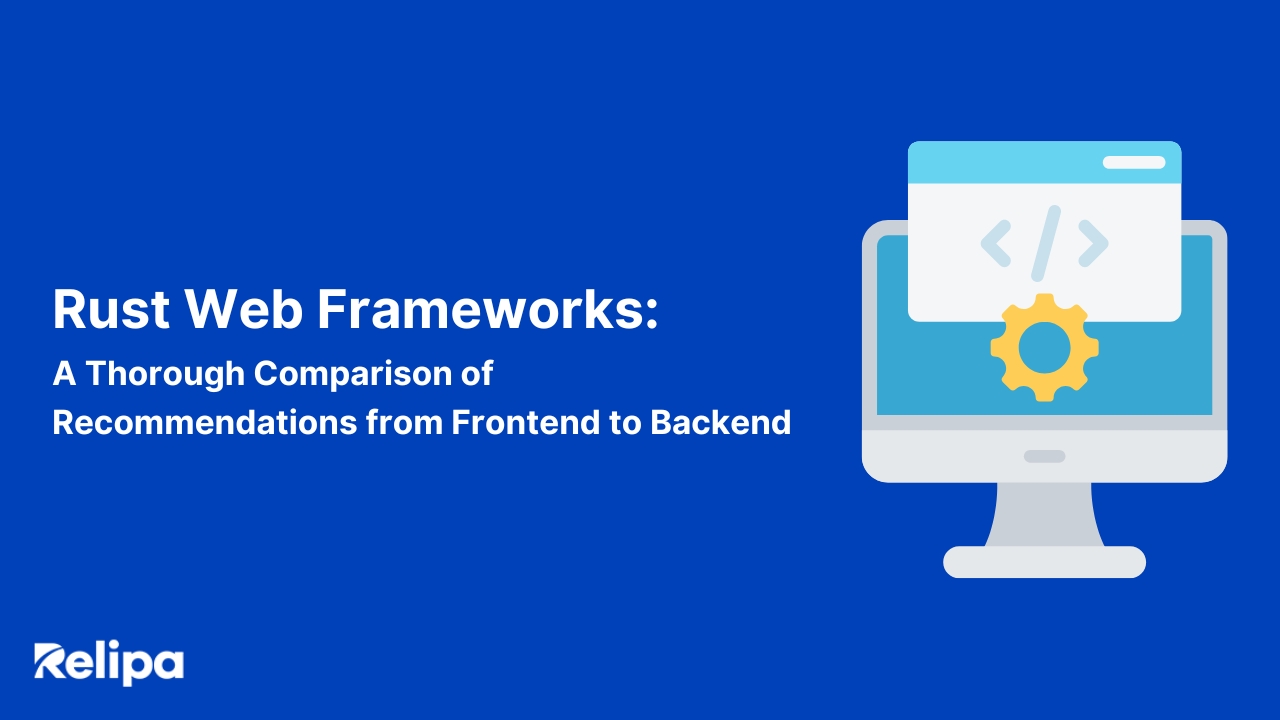Explanation Of PHP: What You Can Do With PHP And The 4 Steps Of Development With An IT Outsourcing Company
What is PHP?
PHP is a programming language that runs on the server side. It is used to develop websites and web applications and can be combined with HTML and CSS to create dynamic web pages. PHP is a free and open-source language used by many websites. Also, the origin of the name of PHP is “Personal Home Page”.
What PHP can and cannot do
For more than 15 years, PHP has been the preferred language for web servers because of a number of advantages. Besides, everything has two sides. Let’s take a look at PHP’s strong points and drawbacks.
What you can do with PHP
- Create dynamic web pages
PHP can be combined with HTML to create dynamic web pages. For example, data received from a web form can be processed and stored in a database.
- Form processing
PHP can be used to process input data for web forms.
It is of the possibility to execute the following tasks:
+ Validate input data
+ Detect error
+ Save to database
+ Change browser display based on user input
This kind of processing is possible and can be used to add movement to web pages, making them more dynamic and engaging for users.
- Cooperation with the database
PHP is a language that makes it easy to work with databases.
The databases that can be linked with PHP are as follows.
+ MySQL
+ Oracle
+ PostgreSQL
PHP supports many databases. PHP development requires a database and can be handled easily.
- File upload
You can use PHP to upload files on your website. You can validate the file type or rename the file.
- Session management
PHP is a language that makes it easy to manage sessions on your website. Session management is the management of a user’s state on a website. For example, it is possible to determine whether the user is logged in or not, and there is a function to display recommended products on My Page.
What PHP Cannot Do
- Game development: PHP is a good language for developing websites and web applications, but not for game development.
- Developing desktop applications: PHP is a server-side language, so it is not suitable for developing desktop applications.
- Image editing: PHP is not suitable for image editing. Special software is required for image editing.
You can also provide information about which projects should be developed in PHP. PHP is suitable for developing websites and web applications, especially when you need to create dynamic web pages and work with databases. PHP also provides many features required for web development, and many popular websites and web applications are developed with PHP. Below are examples of projects that are often developed in PHP.
- CMS (Content Management System): CMS such as WordPress and Joomla are developed in PHP. These systems can provide a framework for managing website content
- E-commerce sites: Many e-commerce sites are also developed in PHP. By using PHP, you can easily register products, process orders, and process payments.
- SNS (Social Network Service): SNSs such as Facebook and Twitter are also developed in PHP. Using PHP, you will be able to register users, login, process posts, etc.
- Blog site: There are many blog systems that use PHP, and WordPress is a typical example. By using PHP, you can easily post and edit articles and manage comments.
- Form services: Form services like Google Forms are also developed in PHP. Using PHP, it is possible to create forms and collect responses.
As mentioned above, PHP is one of the essential languages for web development and is used in many websites and web applications. Developers should choose the appropriate language according to their project requirements.
Popular PHP Frameworks in 2023
Let’s explain the overview and benefits of 10 popular PHP frameworks in 2023.
Symfony
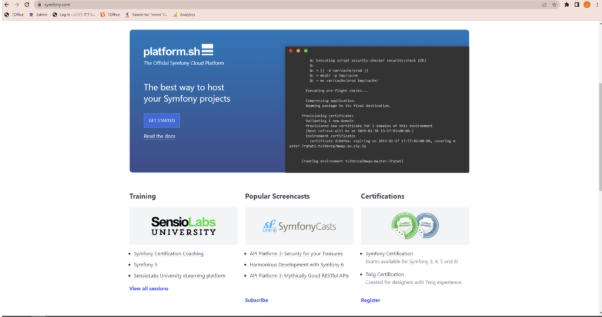
Symfony is a PHP web application framework used to develop websites, applications, APIs, and microservices. It was released in 2005 and is still popular among developers today.
Symfony fully lives up to PHP’s heritage and is built on a set of reusable PHP components. This framework contains a set of libraries, tools, and conventions for organizing and structuring PHP code.
Symfony features are:
Reusable libraries and asy integration.
Symfony is based on an MVC (Model-View-Controller) architecture, which allows you to decompose your application for greater reusability and maintainability. Symfony also includes many features that developers can use to rapidly develop web applications. Additionally, Symfony is community-backed in development, ensuring stability and security. Furthermore, Symfony has a lot of documentation and tutorials, so beginners can easily get started.
Symfony can be applied to various projects such as websites, web applications, APIs, and microservices. Symfony follows the legacy of PHP, making it intuitive and easy to use for PHP developers.
Overall, Symfony is a powerful framework for developing web applications in PHP, favored by many developers. By using Symfony, you can develop high-quality web applications quickly and efficiently.
Symfony is used by popular content management systems such as Drupal and PHP Bulletin Board (PHPBB).
Laravel
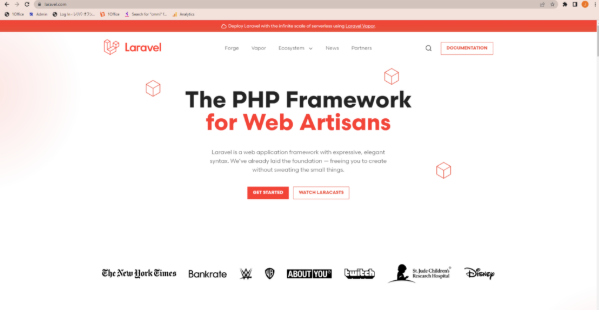
Laravel is a web application framework written in PHP that allows you to easily develop modern and powerful web applications. Laravel builds on components of another tool called Symfony, which provides the set of tools and rules you need when writing PHP code. It also provides a set of best practices and a built-in testing framework to help developers write clean, maintainable code.
Key features of Laravel include:
- Powerful routing system: Laravel makes it flexible and easy to define routes and handle HTTP requests.
- Laravel Homestead: A built-in development environment to help you develop without problems.
- ORM (Object Relational Mapper): Simplifies database interactions and supports multiple database systems.
- Blade: A lightweight templating engine that facilitates the creation of dynamic views.
- Packalyst: Laravel package collection with over 15,000 packages.
- Dependency Injection Support: Supports techniques for managing object dependencies in a flexible and decoupled manner.
- Command Line Interface (CLI): Provides tools for managing and deploying Laravel applications.
Laravel should be used extensively to build web applications of all sizes, from small sites to large enterprise-level applications.
It is known for its elegant syntax, robust feature set, and strong developer community.
CakePHP
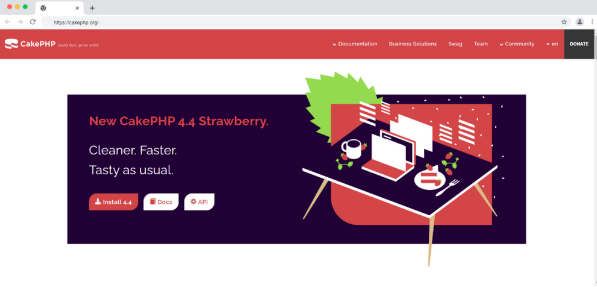
CakePHP is an open-source PHP web application framework used to build web applications. It is based on the Model-View-Controller (MVC) architectural pattern and follows a convention-over-configuration approach. In other words, it provides a set of conventions for organizing and structuring PHP code and requires less configuration than other frameworks.
The main features of CakePHP are:
- A powerful routing system that allows developers to easily define routes and handle HTTP requests
- MVC (Model-View-Controller) architecture that separates the presentation layer and business logic
- Supports multiple database systems with built-in ORM (Object-Relational Mapper) that simplifies database interaction
- A set of tools and libraries needed for common web development tasks such as form validation and session management
- A command line interface (CLI) that provides the tools you need to manage and deploy CakePHP applications
CakePHP is a simple and easy-to-use framework for building web applications that developers want. It is known for its convention-over-configuration approach and clear documentation.
CodeIgniter
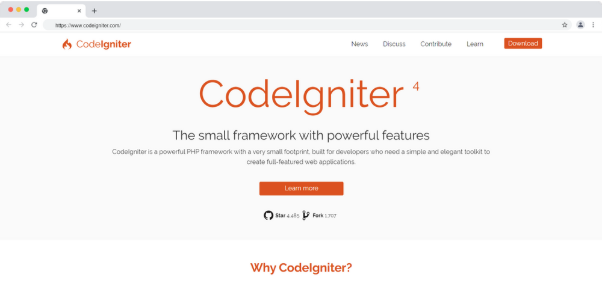
CodeIgniter is an open-source PHP web application framework used to build dynamic websites. Designed to be lightweight and easy to use, with minimal requirements for installation and a small footprint.
Key features of CodeIgniter include:
- A simple and intuitive interface helps developers get started quickly.
- A set of libraries and helper functions to simplify common web development tasks such as form validation and session management.
- Multiple caching enables faster deployment.
- A lightweight MVC-based architecture that separates the presentation layer and business logic.
- A built-in security layer to combat common web vulnerabilities such as XSS and SQL injection attacks.
CodeIgniter is popular with developers looking for a simple, easy-to-use framework for building dynamic websites. It features a small footprint, good performance, and clear documentation.
Laminas
Laminas is an open-source PHP web application framework used for building web applications, APIs, and microservices. Formerly known as Zend Framework. Laminas was built with speed, security, performance, and scalability in mind.
Key features of Laminas include:
- A powerful routing system allows developers to easily define routes and handle HTTP requests
- MVC (Model-View-Controller) architecture that separates the presentation layer from the business logic
- Built-in ORM (Object-Relational Mapper) that supports multiple database systems and simplifies database interactions
- A set of tools and libraries for common web development tasks such as form validation and session management. It also integrates with third-party libraries.
- Dependency Injection support for managing flexible and decoupled object dependencies
Laminas is a good choice for developers who want a comprehensive and feature-rich framework for building web applications. It features a robust function set with a strong focus on performance and scalability. Cisco WebEx and BBC are known to have used Zend Framework to develop their websites.
Advantages of Using a PHP System Development
PHP outsourced system development is an appropriate means for quick and smooth projects. The service has many benefits. Please read to the end so that you can understand the details.
Cash Flow Gap
Cash flow is always a concern, especially for start-ups. If your project is experiencing ups and downs, there can be funding gaps. Hiring an in-house development team at this point may seem like a dream, but it’s not always possible. It’s hard to attract talent if you don’t have the reputation yet and the money to back your promise. Outsourcing software development services or using IT offshore development can be attractive options in these situations. This allows you to create sustainable projects without big cash outlays.
Talented Pool Approach
If you outsource development, you can hire the best developers to develop your ideas. These developers can work on your projects from anywhere in the world and never have to worry about being away from your office. And because you have access to highly specialized developers, you have access to highly specialized developers who know what they’re doing. These developers have been in the industry for years and have worked on all kinds of projects. You can easily do your best work.
Latest Technology and Methods
When you hire a team of PHP developers using PHP Outsourced System Development, you are likely to be able to use the latest tools and techniques. Using the latest frameworks and libraries can greatly increase productivity and reduce development time. You don’t have to hire developers who need training, so you can hire developers who are already familiar with the latest industry trends. And you don’t have to worry about your team being left behind as new technologies are adopted.
Usually, when outsourcing development to a company, the project manager or team leader is responsible for the work. This person will communicate with your team to make sure everything is running smoothly.
Here are the stats for the most popular tech skills in the PHP tech stack in 2021:
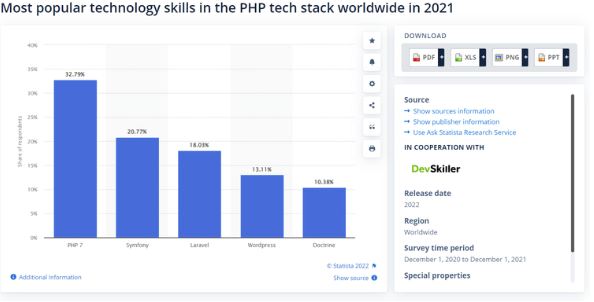
PHP tech stack
Projects Can be Completed Quickly
When you outsource development to a team with a proven track record, you are more likely to deliver your project on time. Developers who have built a reputation for completing tasks quickly may be able to help meet short deadlines.
When you start working with a new development company, negotiating project timelines can be time-consuming. Having an experienced team on hand will help you quickly resolve issues related to delivery deadlines.
Free up Time to Focus on Your Business Goals
PHP outsourced system development is a great way to free up your schedule. Hiring your own team may be preferable, especially when launching a project, but finding the right people can be difficult. Finding, hiring, and managing employees takes a lot of time and attention. Using a PHP outsourced system development is a great way to get your product up and running quickly while staying focused on your business goals.
Four Steps of PHP-entrusted System Development
Now is the time to take a closer look at the main steps to follow when outsourcing PHP development.
Step 1: Determine Project Goals
It is most important to be clear about the problem you want to solve and the business goals you want to achieve, and be as specific as possible. Unless you give the developer enough information about what you want to achieve, you can’t expect the best.
Step 2: Define Project Requirements
Now it is necessary to list the technical characteristics of the future software product. Features are as follows.
- Type of software you want to create (SAAS, enterprise, etc.)
- System architecture (in-house, cloud, etc.)
- Development language (PHP, JavaScript, etc.)
- Type of user (employee, contractor, etc.)
- Desired timeline (rapid, semi-rapid, etc.)
Let’s define the project requirements.
Step 3: Decide on a Timeframe, Location, and Budget
It is important to remember that projects can have unforeseen changes, which can cause delays in delivery. Still, set a deadline you want to achieve.
Besides this, you also have to decide between an American company and an Eastern European company. Eastern Europe has lower costs and often the same quality.
Finally, it’s time to decide on a project budget. Some development providers have flexible pricing models, so you can easily adjust costs to fit your budget.
Step 4: Choose the Right Web Development Outsourcing Company
The final step is to identify the right outsourcing company. This is the most important step, but also the most difficult.
Here are the main things you should check in order to define the correct PHP development partner.
- Check the company’s portfolio of work (make sure this team has already worked on similar projects).
- Read client reviews (client reviews mean a lot when choosing the right development partner. See if the company has a strong reputation and if there are any complaints from previous clients).
- Seek client references (you can contact the company’s previous clients directly and ask them about their experience and if they would recommend the company).
- Evaluate the quality of their website (check their website to see if it’s updated regularly. A company’s website is the first thing a client sees and it’s associated with its brand should reflect your expertise).
- Evaluate the team’s level of expertise (The team will make sure that they have at least a few years of PHP development experience. Looking at their strengths will determine how well they develop.)
Fees and Hidden Costs for PHP Outsourced System Development
Outsourcing PHP development is a great way to save money, but it’s natural to want to know how much this service will cost. Let’s take a closer look at the average cost of this service.
Fee for PHP Consignment System Development
Unfortunately, we are unable to provide an exact price as the final cost of hiring an outsourced PHP programmer will depend on the location of the outsourcing company and the complexity of the project. The market for offshore development in Asia is constantly growing, making it a lucrative offshore destination.
Offshore developer costs in countries such as China, Vietnam, and India average 310,000 yen per month. However, it can vary significantly by country, project complexity, and level of expertise.
Hidden Costs of PHP Outsourced System Development
Obviously, outsourced PHP development is a good solution for many people because of the low upfront costs. But you should know that there are hidden costs.
Overtime (and this means over budget)
- Software development is a 100% unpredictable process, so you may need to work overtime if you want to get work done in a hurry. However, you can overcome these challenges with the right approach. At EAB, we do our best to run the discovery phase, analyze the scope of work, and control the workflow.
The additional cost of travel due to poor communication
- At EAB, I have extensive experience in remote work, team management, and development processes. Use various software products to create remote communique
Address your concerns and contact an expert today to get an accurate quote for your future project. 100% transparency and cost control guaranteed!
Reasons for Outsourcing the PHP System Development Service of Relipa
Relipa has 7 years of experience working as a corporate contractor. Aiming for cost-efficiency and efficient offshore development, BrSE, with excellent English language skills, project managers, and high-quality developers, will guarantee quality while conducting “reporting and consultation” 100% in English during the contract period.
Having 7 years of experience working as IT outsourcing partners of various Japanese clients, both SMEs and MNCs in the fields of IoT, Blockchain, Web 3.0, and Artificial Intelligence, Relipa holds a firm belief that not only can our tech-savvy engineers apply this experience in the Global Market, but they can also consult and provide high-quality services, especially in developing PHP system.

